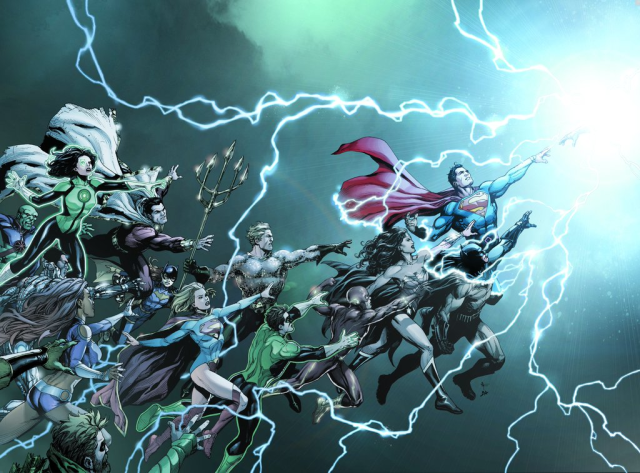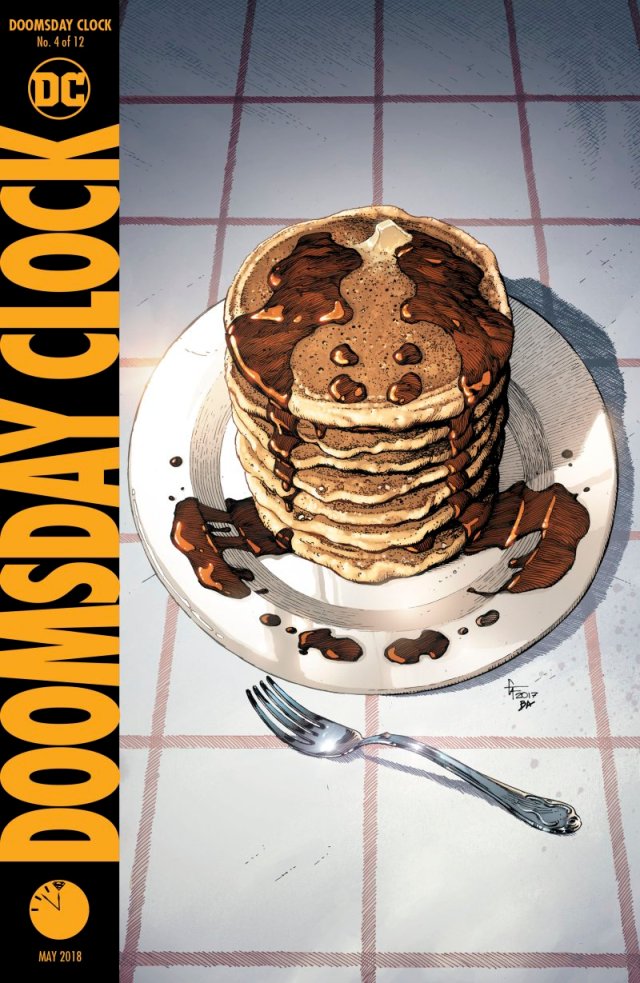
I don’t know, some kind of sports joke or something?
The New 52 is dead. And it seems like some folks are celebrating.
The 2011 DC Comics publishing initiative more or less rebooted the entire line of comics back to issue #1. It was a pretty ballsy move, not because it reset the numbering of comic books that were on their nine hundredth plus issue, or because it retooled seventy plus years of continuity, but because with the New 52 DC Comics made an executive decision to make an appeal to prospective new readers rather than continuing to placate existing ones.
It’s a debatable decision. It’s easy to spin it as corporate interests turning their backs on longtime, loyal fans in favor of younger blood. Maybe that’s exactly what happened. But as the younger blood in question I can’t help but mourn the euthanizing of the New 52.
I read my first graphic novel well into my teens and dabbled in further readings once a summer or so until The Dark Knight trilogy concluded and I wanted more Batman. I read the pillars of Batman mythology before moving on to Superman books and then I found my way to Geoff Johns’ Green Lantern, which got me hook, line and sinker, so much so that when I caught up on the trade paperbacks I couldn’t wait for the next one and decided to brave a real live comic book store and pick up actual floppy comic books.
I had no intention of reading any other book, but when I looked down the rack at the Batman comics and the Aquaman comics and the Justice League comics they weren’t at issue #999 or even issue #99. They were on issue #12. That didn’t seem so daunting. I could catch up with that. And I did. And now I read comics.
Sure, now I understand that the number on a comic doesn’t really mean as much as the creative team does and that Detective Comics #69 isn’t required reading for Detective Comics #666 (I’m assuming) but back then if I’d looked down the rack and seen Batman #1,000,000 my curiosity would’ve been far outnumbered.
But the reset numbering wasn’t fandom’s biggest point of contention with the New 52. The New 52 didn’t do a hard reset on continuity. Green Lantern, for instance, pretty much picked up where it had left off. Batman had an eerily similar status quo that alluded to events in old continuity without ever firming establishing a timeline. The biggest overhaul, however, was the idea that in New 52 continuity superheroes had only been a whole “thing” in the DC universe for five years. So books like the Teen Titans, featuring a lineup of teenaged former sidekicks, got pretty confusing, as did the fact that Batman had four Robins after being active for only five years.
Condensing the timeline squashed and confused a lot of character histories and dynamics that had been established over the course of decades. Popular properties like the Teen Titans never really got to shine and for many the convoluted, sloppy continuity of the New 52 was to blame.
Enter last week’s DC Rebirth, the 80-page one-shot by Geoff Johns and a stable of top-shelf artists (Phil Jiminez, Ethan Van Sciver, Ivan Reis, Gary Frank) that ended the New 52 in style. The book is built on the sentiment that in the New 52 DC Universe “something is missing.” It calls the New 52 to task for being dark and brooding and hopeless and apparently pissing on the lineage of DC’s greatest heroes.
It’s a great book, but it can be a bit much when it comes to flogging the New 52. For fans who were brought into the fold with the New 52 it kind of feels like being invited to a party by an acquaintance and then watching them extensively apologize to the assembled for inviting you.
The New 52 is not to blame for DC’s lineup of gritty books any more than it is to blame for fans of the Teen Titans not getting an iteration of the team they like for the last five years.
That all comes down to what’s on the page.
I’ve got no problem with the New 52 coming to an end, but people have gone far beyond letting the door hit it on the way out. Changing continuity doesn’t just magically make a publishing line more optimistic and fun. Declaring the New 52 over doesn’t just magically make the Teen Titans great again. It comes down to the individual comic books themselves.
When I’m reading an awesome issue of Batman I don’t give a shit what the status of the Multiverse is, or whether Superboy Prime is canon or who was responsible for Flashpoint. The only thing that matters is what’s on the page.
The New 52’s condensed continuity might have been contradictory and convoluted but it didn’t terminated the potential for a cool Teen Titans story any more than it guaranteed the certainty of an excellent Batman book. Whatever “something” was missing from the New 52 had nothing to do with the state of the DC Universe or its continuity.
All the New 52 did was turn the gaze of the DCU toward the uninitiated because comic book fans get old and die and have to be replaced with new comic book fans.
I loved the New 52, but I’m excited for DC Rebirth because of the wealth of new talent and creative teams it’s bringing to its characters. For better or worse when the spiffy, post-New 52 Teen Titans book shows up on stands it’ll be that talent that will be on display on the page creating the story, not a publishing initiative and not continuity.



